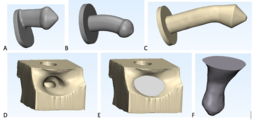Customized Tracheocutaneous Fistula and Tracheostomy Plug
TECHNOLOGY NUMBER: 7560

OVERVIEW
Customized, 3D printed tracheostomy plugs for individual patients- A medial grade silicone plug that is self-retained in the tracheostomy site
- Reduces skin irritation, air leaks, swallowing troubles, and diminished voice
BACKGROUND
Tracheostomy is a surgical procedure wherein an incision is created along the trachea (windpipe) to open the airway. The resulting tracheostomy opening, or stoma, in the anterior lower neck serves as an independent airway or a site for placement of a tracheostomy tube. Limitations faced by tracheostomy patients include local skin irritation, difficulties with speech, trouble swallowing, limitations with bathing, and facing a social stigma. These issues may be addressed by the placement of either a capping or plugging device in the tracheostomy site, though these approaches suffer from shortcomings, as well. For example, caps and plugs are not customizable to individual anatomy and may lead to a poor fit that can require surgical placement or emergency removal in certain cases. Even those caps which fit well require a neck tie to keep them in place. As such, a need exists for an improved method to create tracheostomy caps and plugs which minimize the aforementioned problems.
INNOVATION
Inventors have created a custom fitted, three-dimensionally (3D) printed tracheostomy plug that is designed to match each patient’s airway using modeling. The 3D modeling is based upon information acquired from computerized tomography (CT) scans, magnetic resonance imaging (MRI) scans, or 3D surface scans. The 3D information is utilized by computer aided design modeling software to create a 3D printed, medical silicone grade plug that is self-retained in the tracheostomy site. The plugs are low profile and fully seal to the tracheostomy site, which reduces both skin irritation and air-leak secretion. The soft silicone material enhances patient comfort, optimizes swallowing functions, and enables an improved voice strength. The inserted end of the plug is wider than the narrowest portion of the tract, while the remainder of the plug is the exact dimension. Externally, there is a flange that is significantly wider than the tract and prevents aspiration. Unlike existing devices, this tracheostomy plug can be easily removed and replaced by the patient, without any need for the use of neck ties. This technology has broad clinical relevance to patient airway management.